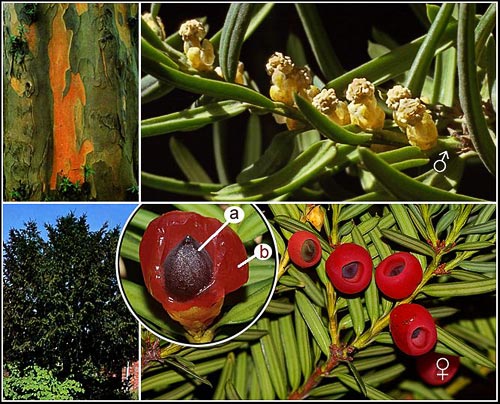Relatives
Taxus baccata L. - European Yew.
Taxonomic position.
Family Taxaceae S.F.Gray genus Taxus L.Morphology and biology.
Evergreen tree up to 20 m tall and about 1 mm diameter, reaches age of 2,000 years. Bark red-grey, red-brown or grey-brown, smooth or scaly. Leaves up to 3.5 cm long and 2 mm wide, above dark green, shiny, beneath pale-colored, dull, with small keel, slightly revolute at margins. Male flowers condensed on lower branch surface, up to 5 mm long, with 10 stamens. Female flowers solitary, distant from one another, surrounded with scales at base. Fruits red, globose, open above; seed very hard, oval, brown with fine dots; fleshy ring around seed bright crimson, juicy, sweet. Dioecious, rarely monoecious, anemophilous. 2n=?.Distribution.
Baltic states, Carpathians, Crimea, Caucasus; West Europe, Asia Minor, Northern Africa.Ecology.
Usually in the second layer of coniferous-broad-leaved forests (in Baltic states) and montane beech forests (Carpathians, Crimea, Caucasus).Use and economic value.
Valuable timber tree; leaves and fruits used in medicine.References:
Sokolov SI., Svjaseva OA., Kubli VA. 1977. Ranges of trees and shrubs of the USSR. V.1. Leningrad: Nauka. 240 p. (In Russian).Grossheim AA. 1939. Flora of Caucasus. 2nd ed. V.1. 402 p. (In Russian).


